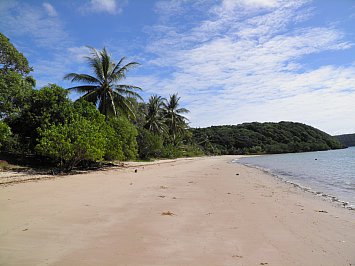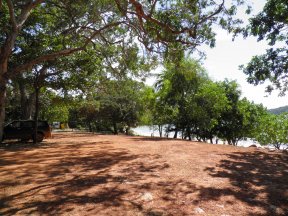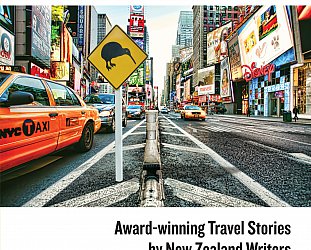Graham Reid | | 2 min read

So this was to be the site of a city to rival Singapore, this short crescent of white sand fringed by palms and mangroves, and looking onto a deep channel towards a nearby island?
On a quiet day – and every day is quiet at this place at the tip of Queensland not far from Cape York – this place has a certain escapist appeal.
A few come to launch boats warily in the crocodile inhabited waters and go fishing, but mostly no one comes to remote Somerset – because there's no reason to come, unless you don't want to be disturbed.
On the Cape York Peninsula the population is only about 17,000 in an area more than half the size of Great Britain. Which means Somerset isn't just an hour or two away from somewhere, it is hours from anywhere and in the dry season the trip there is along dusty unsealed roads. In the wet season . . . you can guess.
Yet 150 years ago lonely and lovely Somerset was intended to be the site of a city which would draw the maritime traffic on its way to or from the busy port of Singapore.
Somerset would be a magnet as a trading post and to that end the newly established Queensland state government – fearful also of colonisation by the Dutch and French – despatched a group of 20 marines here to support the local entrepreneur and farmer John Jardine's station.
Around here was once the largest rubber planation in Australia, and Jardine and the marines built a wharf (a few remaining post can be seen in the sand). The Jardine household on the hill was surrounded by gardens and an orchard.
There is much history here, not the least involving John's son Frank who, with his brother Alexander and a crew, drove 250 cattle for 10 months up from Rockhampton, eventually arriving in 1865 with just 50 head left and a reputation for having proudly massacred as many as 200 Aboriginal people along the way. Volatile and murderous Frank later married a teenage niece of the King of Samoa. They are buried near the beach.
But in the absence of sufficient water here and after the government lost interest, the marines pulled out and over the decades Somerset slowly sank back into scrub, the gardens went wild and the buildings crumbled. Today there's nothing to suggest a city that could have rivaled Singapore.

But there's no Orchard Road, no equivalent to Raffles, no high rise buildings or the world's busiest container port.
Just an attractive beach you can't swim at because of the crocodiles and shady area where people launch boats.
Somerset is a pretty place where on a good day you can lie in the sun and dream undisturbed.
But it's also a place where a dream died.





post a comment